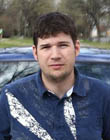|
|
This topic comprises 2 pages: 1 2
|
|
Author
|
Topic: Digital Demostration at the Transit Drive-In
|
|
|
John Pytlak
Film God

Posts: 9987
From: Rochester, NY 14650-1922
Registered: Jan 2000
|
 posted 05-18-2006 02:21 PM
posted 05-18-2006 02:21 PM





I was there. For this test, a NEC Model NC2500F (6KW lamp) Projector was used, along with a QuVis server. The projector was used without the optional 1.25X anamorphic lens, which would add about $10,000 to the cost. A selection of trailers, intermission snipes, and the first half of "The Chronicles of Narnia" was projected on the freshly-painted screen at the Transit Drive-In in Lockport (just north of Buffalo) NY.
Light levels measured by NEC for various image widths on the screen were reported to be about 10 footlamberts for 70 feet wide, 8.4 footlamberts for 80 feet wide, and about 6 footlamberts for 100 feet wide.
Most of the 100 or so people at the demo agreed the demo looked very good.
The business case and financing options generated the most discussion at the presentation by Terri Westhafer (NEC), and John Wolski and Pat Moore (Strong) held before the demo, since the estimated cost of the equipment used for the demo was about $100,000. As noted, the more efficient optional 1.25X anamorphic lens would have added an additional $10,000.
| IP: Logged
|
|
Tim Reed
Better Projection Pays

Posts: 5246
From: Northampton, PA
Registered: Sep 1999
|
 posted 05-18-2006 06:33 PM
posted 05-18-2006 06:33 PM




John, I had no idea you were going to be there! Unfortunately, I couldn't make it. I was there in spirit, if nothing else; I was on the phone to a couple of attendees during the program.
Screen Attractions, the company that Justin West and I formed to produce new and digitally-remastered specialty trailers for the drive-ins, was invited to participate in this screening. Over the past few weekends, I assembled a cross-section of segments from our intermission clock, institutionals, psa's and concession snipes -- along with some custom animation just for this show. From all reports, the screening was a rousing success, as I had no doubt it would be.
I was also very proud to hear that the Screen Attractions presentation was a hit! We have become the first producer to provide DC drive-in trailers, in native digital form. Certainly, Filmack was represented at the screening, although their material originated from an NTSC videotape.
When I get a file rendered that's small enough to post, I'll put up a link to the program we made. There's a gag in it that I hear made some attendees cheer! ![[Smile]](smile.gif) (Which really renewed my desire to ditch the 18-wheeler and become an animator!) We also used the screening to unveil our new name and logo. (Which really renewed my desire to ditch the 18-wheeler and become an animator!) We also used the screening to unveil our new name and logo.
I'd like to personally thank Rick Cohen, owner of the Transit Drive-In, for this unique opportunity to be a part of history.
| IP: Logged
|
|
|
|
|
|
|
|
|
|
|
|
|
|
|
|
|
|
|
|
Jack Ondracek
Film God

Posts: 2348
From: Port Orchard, WA, USA
Registered: Oct 2002
|
 posted 05-22-2006 10:55 PM
posted 05-22-2006 10:55 PM





There was no comparison, though I'll leave it to others to explain why. Could have been any number of reasons.
The single bulb in use was a 6,000 watt Helios. The last figure I was told (by one of the techs) is that it was running higher than 6,000 watts. One tech said it was at somewhat over 7,000. Another said it was higher, though the figure he quoted seems pretty high for a 6k bulb. I never saw the display read over 102%, though just that level had a tech or two fairly excited.
In any case, they said that higher-wattage bulbs could be used in that projector. The 6K is what they had to work with that night, and they certainly were looking to get the most out out of it they could.
There have been comments made about how this higher wattage level was needed to get the digital projector to compare favorably with the theatre's normal 4.5k Highlight console. One thing that makes the comparison unfair is that the digital projector was able to provide a much more uniform field with that extra wattage. The 35mm system had to be narrowly focused (read 'hotspot')to get levels acceptable to the owner. I suppose it might have been interesting to drop the digital lamp down to 4.5k, though even then they'd have had to tighten the focus to get a fair comparison.
| IP: Logged
|
|
Scott Norwood
Film God

Posts: 8146
From: Boston, MA. USA (1774.21 miles northeast of Dallas)
Registered: Jun 99
|
 posted 05-28-2006 07:37 PM
posted 05-28-2006 07:37 PM





Article from today's Boston Globe
quote:
Coming soon: the digital drive-in movie theater
By Scott Kirsner | May 28, 2006
The owners of the 406 surviving drive-in theaters in the US have long memories: They can recall 10-cent Cokes, B-movies like ``I Was a Teenage Frankenstein," and tail-finned Cadillacs driving off with the speaker still clipped to the window.
And many use the same equipment from the golden age of the double feature: At the Wellfleet Drive-In, for example, the original projector from 1957 is still switched on every summer evening.
The country's remaining drive-ins, including five in Massachusetts, have managed to endure the onslaught of television, the multiplex, and the VCR, as well as the rising real estate values that can make selling the land beneath a drive-in irresistible. But the newest concern among drive-in owners is the advent of digital projection and the predicted obsolescence of celluloid.
``I would not want to bet my business on the ability to keep obtaining 35-millimeter film prints into the future," says John Vincent, one of the owners in Wellfleet. ``We've taken a keen interest in digital projection because we want to be around for the next 50 years or so."
Hollywood studios have been talking about a filmless future since at least 1999, when movies like ``Tarzan" and ``Star Wars: Episode I" were shown digitally in several indoor theaters. If the studios could send movies to a projection booth in digital form, either via satellite or on hard drives, they could avoid producing hundreds or thousands of celluloid copies when a movie is released, shipping them around the country, and then collecting and destroying them afterward.
Digital distribution would save the studios millions in distribution costs each year, but it requires theaters to install a digital projector and related gear in the projection booth. Until recently, the technology had only been tested and installed in indoor theaters -- not ``ozoners," as the Hollywood trade paper Variety has dubbed drive-ins.
That situation got some drive-in owners thinking back to an earlier transition in the movie business, when theaters first installed sound equipment in the late 1920s. Thousands of theaters that couldn't pay for the equipment, or didn't move fast enough, went out of business.
``We don't want to see any drive-in theaters become victims of the digital transition," says Rick Cohen, owner of the Transit Drive-In in Lockport, N.Y., near Buffalo. ``But because we're not a big segment of the movie exhibition industry, we're not the number one concern of the companies making digital projectors or servers," the computers that store the digital version of a movie.
Of the estimated 36,000 movie screens nationwide, just 657 are outdoors . At a trade show last fall, Cohen got the attention of one manufacturer of digital projectors, NEC Corp., suggesting that the company demonstrate one of its projectors at his drive-in.
``To be honest, I had kind of written off drive-ins," says Terry Westhafer, a consultant who works with NEC to develop relationships with theater owners. ``I figured they'd stay around until film died, and then have swap meets."
But the more Westhafer learned, the more she was convinced that drive-ins could represent a viable market segment. Since the 1990s, 36 drive-ins have been built, and 60 shuttered drive-ins have reopened. (While the number of drive-ins is still in decline, there has been a small uptick over the past three years, according to the United Drive-In Theater Owners Association, but their numbers remain far from a peak of about 4,000 in 1958.)
And drive-ins have always had trouble getting a bright enough image on the screen, since if the projector's bulb is too bright, it can burn through the film; NEC boasts of having the brightest digital projector available.
Earlier this month, about 100 members of the drive-in theaters group gathered at the Transit Drive-In for what Cohen and others believe was the first demonstration of digital projection at a drive-in. They watched ``The Chronicles of Narnia," preceded by some vintage material that had been digitized, including the memorable animated dancing hot dog that entices the audience to visit the concession stand.
``With any mechanical projection system, a shaky image is sort of inevitable," says Wellfleet Drive-In's Vincent, who chairs the digital cinema committee established by the owners' association. ``But digital is rock solid."
Digital projection could also increase the revenue that drive-in owners earn from advertising shown before the movie, or between the halves of a double feature.
But digital cinema comes with a jumbo-sized price tag. The NEC projector alone costs between $90,000 and $100,000, though the price is expected to drop as sales volume grows. Cohen and other drive-in owners, like their counterparts at indoor cinemas, aren't eager to foot the cost of the equipment on their own, since its installation will in large part benefit the studios by lowering distribution costs.
Several companies, including Technicolor and a New Jersey company called AccessIT, are offering to finance the digital projection equipment for indoor theaters, limiting their outlay by charging the studios a fee each time the studios send out a digital release. But those companies haven't begun serious discussions with drive-in owners.
``The target that everyone is going for are the large-grossing indoor theaters, where you can get the most bang for the buck," says Russell Wintner, an executive at AccessIT. (Wintner, one of the pioneers of digital cinema, also happens to own a single drive-in in Cleveland.) In Wellfleet, Vincent says he doesn't think he'll be replacing his 50-year-old projector with a digital model this summer or in 2007, but perhaps by 2008. If enough of his peers follow suit, the ozoner, long on the endangered list of roadside Americana, will have miraculously outlived film.
Scott Kirsner is a freelance writer in San Francisco who maintains a blog on entertainment and technology, cinematech.blogspot.com. He can be reached at kirsner@pobox.com.
© Copyright 2006 The New York Times Company
| IP: Logged
|
|
|
|
|
|
All times are Central (GMT -6:00)
|
This topic comprises 2 pages: 1 2
|
Powered by Infopop Corporation
UBB.classicTM
6.3.1.2
The Film-Tech Forums are designed for various members related to the cinema industry to express their opinions, viewpoints and testimonials on various products, services and events based upon speculation, personal knowledge and factual information through use, therefore all views represented here allow no liability upon the publishers of this web site and the owners of said views assume no liability for any ill will resulting from these postings. The posts made here are for educational as well as entertainment purposes and as such anyone viewing this portion of the website must accept these views as statements of the author of that opinion
and agrees to release the authors from any and all liability.
|

 Home
Home
 Products
Products
 Store
Store
 Forum
Forum
 Warehouse
Warehouse
 Contact Us
Contact Us




 Printer-friendly view of this topic
Printer-friendly view of this topic








![[Smile]](smile.gif) (Which really renewed my desire to ditch the 18-wheeler and become an animator!) We also used the screening to unveil our new name and logo.
(Which really renewed my desire to ditch the 18-wheeler and become an animator!) We also used the screening to unveil our new name and logo. ![[Cool]](cool.gif)

![[thumbsup]](graemlins/thumbsup.gif)








